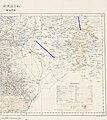|
Batanaea Batanaea or Batanea was an area often mentioned between the first century BC until the fourth century AD. It is often mixed with the biblical Bashan as its hellenized/latinized form (of Bashan) and as a part of the Biblical Holy Land, northeast of the Jordan River. According to old explorations, maps and research, the Batanea was much more a part between the two Trachones mentioned by Strabon. Many maps reveal that the Ard[dubious – discuss] of Batanea was at the east of the Leja region[1] (the common Herodian Trachonitis). Bashan was, in biblical context, the whole region east of the Jordan, above Gadara and Abila until the Jebel el Druz, the old Hauran (Bashan) mountains. HistoryBataneaea was one of the four post-exile divisions of the area of Bashan. Today, as it was during Greco-Roman times, Batanaea is more commonly considered to be the area east of the Leja. The region south of the Leja and west of the Hauran (Auranitis) called Nuqrah[2] to the southwestern edge of the Leja is sometimes falsely called Batanaea. This is because of the permanent mix with the name of the Basan/Bashan region. The biblical Bashan/Basan was the whole area from Adra (Deraa) at its ancient capital to the Hauran mountains. Its highest peak may be the Hill of Basan referenced in Psalm 68:15. In the 1st century AD, the land was acquired by Herod the Great, who established a community of Jews from Babylon who were brought to Batanaea for the purpose of maintaining order against the banditry of the Trachonites.[3] Upon Herod's death in 4 AD, Batanaea passed to his son Philip as part of his inheritance. In some sources, Philip is referred to as the "Tetrarch of Batanea" with the capital at Caesarea Philippi, although his lands were more extensive than this. On Philip's death in 34 BC, Batanea briefly became part of the Roman province of Syria, but in 37 BC it was established as a kingdom and passed to king Herod Agrippa I, and in 53 BC to his son, king Herod Agrippa II. Following his death, it was once again annexed to the Roman province of Syria. New TestamentD. A. Carson, in his commentary on the Gospel of John, says that the "Bethany across the Jordan" of John 1:28 is actually Batanaea, transliterated from Aramaic to Greek. It is thus distinct from the other, more prominent Bethany in the gospels. This contradicts the general consensus, which is that Bethany across the Jordan is situated on the Jordan River near Jericho, on either the east or west bank of the river. Maps
References
Further reading |










